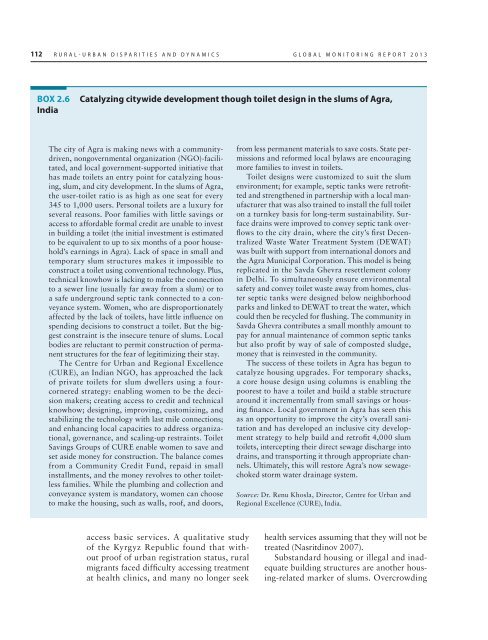rural-urban dynamics_report.pdf - Khazar University
rural-urban dynamics_report.pdf - Khazar University
rural-urban dynamics_report.pdf - Khazar University
You also want an ePaper? Increase the reach of your titles
YUMPU automatically turns print PDFs into web optimized ePapers that Google loves.
112 RURAL-URBAN DISPARITIES AND DYNAMICS GLOBAL MONITORING REPORT 2013<br />
BOX 2.6<br />
India<br />
Catalyzing citywide development though toilet design in the slums of Agra,<br />
The city of Agra is making news with a communitydriven,<br />
nongovernmental organization (NGO)-facilitated,<br />
and local government-supported initiative that<br />
has made toilets an entry point for catalyzing housing,<br />
slum, and city development. In the slums of Agra,<br />
the user-toilet ratio is as high as one seat for every<br />
345 to 1,000 users. Personal toilets are a luxury for<br />
several reasons. Poor families with little savings or<br />
access to affordable formal credit are unable to invest<br />
in building a toilet (the initial investment is estimated<br />
to be equivalent to up to six months of a poor household’s<br />
earnings in Agra). Lack of space in small and<br />
temporary slum structures makes it impossible to<br />
construct a toilet using conventional technology. Plus,<br />
technical knowhow is lacking to make the connection<br />
to a sewer line (usually far away from a slum) or to<br />
a safe underground septic tank connected to a conveyance<br />
system. Women, who are disproportionately<br />
affected by the lack of toilets, have little influence on<br />
spending decisions to construct a toilet. But the biggest<br />
constraint is the insecure tenure of slums. Local<br />
bodies are reluctant to permit construction of permanent<br />
structures for the fear of legitimizing their stay.<br />
The Centre for Urban and Regional Excellence<br />
(CURE), an Indian NGO, has approached the lack<br />
of private toilets for slum dwellers using a fourcornered<br />
strategy: enabling women to be the decision<br />
makers; creating access to credit and technical<br />
knowhow; designing, improving, customizing, and<br />
stabilizing the technology with last mile connections;<br />
and enhancing local capacities to address organizational,<br />
governance, and scaling-up restraints. Toilet<br />
Savings Groups of CURE enable women to save and<br />
set aside money for construction. The balance comes<br />
from a Community Credit Fund, repaid in small<br />
installments, and the money revolves to other toiletless<br />
families. While the plumbing and collection and<br />
conveyance system is mandatory, women can choose<br />
to make the housing, such as walls, roof, and doors,<br />
from less permanent materials to save costs. State permissions<br />
and reformed local bylaws are encouraging<br />
more families to invest in toilets.<br />
Toilet designs were customized to suit the slum<br />
environment; for example, septic tanks were retrofitted<br />
and strengthened in partnership with a local manufacturer<br />
that was also trained to install the full toilet<br />
on a turnkey basis for long-term sustainability. Surface<br />
drains were improved to convey septic tank overflows<br />
to the city drain, where the city’s first Decentralized<br />
Waste Water Treatment System (DEWAT)<br />
was built with support from international donors and<br />
the Agra Municipal Corporation. This model is being<br />
replicated in the Savda Ghevra resettlement colony<br />
in Delhi. To simultaneously ensure environmental<br />
safety and convey toilet waste away from homes, cluster<br />
septic tanks were designed below neighborhood<br />
parks and linked to DEWAT to treat the water, which<br />
could then be recycled for flushing. The community in<br />
Savda Ghevra contributes a small monthly amount to<br />
pay for annual maintenance of common septic tanks<br />
but also profit by way of sale of composted sludge,<br />
money that is reinvested in the community.<br />
The success of these toilets in Agra has begun to<br />
catalyze housing upgrades. For temporary shacks,<br />
a core house design using columns is enabling the<br />
poorest to have a toilet and build a stable structure<br />
around it incrementally from small savings or housing<br />
finance. Local government in Agra has seen this<br />
as an opportunity to improve the city’s overall sanitation<br />
and has developed an inclusive city development<br />
strategy to help build and retrofit 4,000 slum<br />
toilets, intercepting their direct sewage discharge into<br />
drains, and transporting it through appropriate channels.<br />
Ultimately, this will restore Agra’s now sewagechoked<br />
storm water drainage system.<br />
Source: Dr. Renu Khosla, Director, Centre for Urban and<br />
Regional Excellence (CURE), India.<br />
access basic services. A qualitative study<br />
of the Kyrgyz Republic found that without<br />
proof of <strong>urban</strong> registration status, <strong>rural</strong><br />
migrants faced difficulty accessing treatment<br />
at health clinics, and many no longer seek<br />
health services assuming that they will not be<br />
treated (Nasritdinov 2007).<br />
Substandard housing or illegal and inadequate<br />
building structures are another housing-related<br />
marker of slums. Overcrowding

















